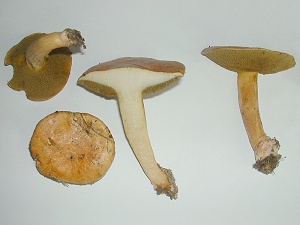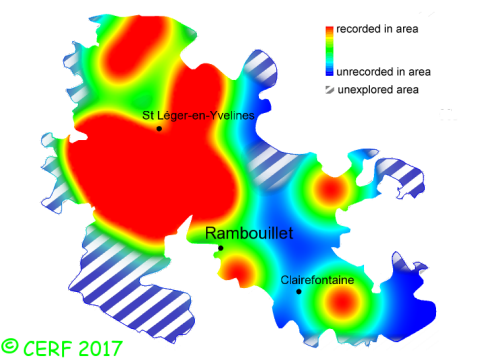| Suillus bovinus (L.:Fr.) Kuntze |
|
|
|
|
|
|
The cap is tawny, dark yellow to orange-brown, not very fleshy, of convex then expanded shape, often bumpy at the centre and eventually depressed. The cap surface is smooth, slimy and sticky when damp, shiny and wrinkled when dry, thin and entirely peelable. The cap margin is thick, white when young, smooth and clean, more or less irregularly wavy. The stem is firm, full, elastic, rather short and thin, without grains or dots, sometimes streaked vertically. It is of more or less equal diameter, often sinuate, thickening close to the tubes, and without any ring. It is of the same colour as the cap, or paler, with pink mycelium at the base.. The flesh is thick in the cap, elastic, firm in the young specimens, then soft and often full of maggots in the cap. It is white to pale cream-yellow, becoming a bit reddish or blueish when exposed to air, and tawny orange in the stem; its taste is very faint, mild or slightly bitter; the odour is weak (fruity or of puffball, according to authors); The tubes are decurrent, large, short (4-10 mm), and not easily removed from cap. They are beige then mustard yellow and eventually brown. The pores are large (1 to 2,5mm wide), angular, toothed, elongated, containing 4 or 5 smaller pores. They are whitish to brown yellow then olive brown and they turn brown when pressed. The spore print is olive brown. It grows in pine woods, with conifers in all sorts of damp places. It is found in large colonies, sometimes in tufts of a few individuals, on a rather acid soil, with two-needle pines (Scots pines). The fruiting period takes place from June to November.
Distinctive features : slimy, buff to tawny brown cap; large yellow pores, irregular, containing smaller pores inside; decurrent tubes, not easily separated from cap; stem without ring; coming in large troops, sometimes tufted, under pines, privileging damp areas Suillus bovinus is occasional and widely present in the forest of Rambouillet, and is occasional, more generally speaking . | ||
|
page updated on 14/01/18

